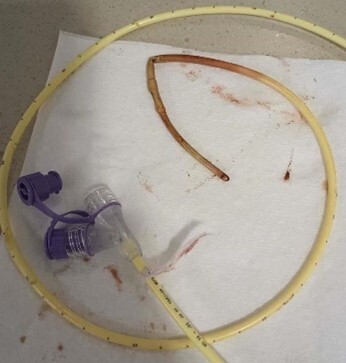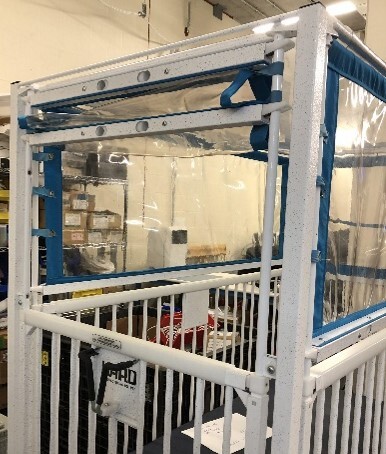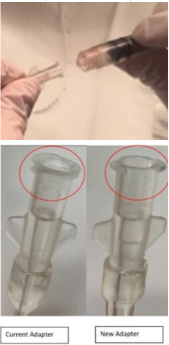|
 
September 2024
Volume 24, Issue 9
The U.S. Food and Drug Administration’s (FDA) MedSun program provides this monthly newsletter to inform patients and patient advocates about FDA information on medical device related topics. The MedSun program, launched in 2002 by the FDA’s Center for Devices and Radiological Health (CDRH), uses a secure online reporting system to receive medical device adverse event reports from a network of over 300 clinical facilities across the United States. MedSun sites work collaboratively with the FDA to assist in detecting, understanding, and sharing information concerning the safety of medical products and play a critical role in the FDA’s postmarket surveillance efforts.
|
|
|
The reports that follow represent a cross section of device related events sent by MedSun Representatives during the prior month. The reports are presented as submitted by MedSun Representatives and in some instances, have been summarized and edited for clarity.
|
|

Type: Tubes, gastrointestinal (and accessories)
Manufacturer: Avanos Medical, Inc.
Brand: Avanos
UDI-DI: 00350770460291
Model: 40-7361
Cat: 40-7361
Event: The patient had an order for a Corflo 10Fr feeding tube insertion. On the first insertion attempt, the tube was placed without issue. A chest X-ray confirmed appropriate tip insertion. The probe was removed, and the tube could not be flushed. The nurse removed the tube, and saw the tip was severely bent/kinked which did not allow it to be flushed. A new Corflo 10Fr tube was obtained and inserted without any issues. A chest X-ray was obtained. The nurse reviewed the image on the computer and noticed that it was in the right lung. The nurse notified the physician and removed the Corflo tube. Additionally, a collapsed lung was present, so a general surgeon was consulted. The patient needed chest imaging with contrast, windpipe tube insertion, and chest tube insertion. A bedside test was performed to evaluate for a hole in the esophagus. Under guidance with the endoscope, the general surgeon inserted a new Corflo 10Fr feeding tube. After an x-ray confirmation of this tube, the probe was removed, and it would not flush. Four nurses attempted to troubleshoot this problem unsuccessfully. The intensivist physician was notified. Another nurse said that she has also had recent issues with our Corflos kinking and having placement difficulties. Staff are wondering if there is a manufacturing defect with the tubes.
|
Device 1 - Type: Pump, infusion, PCA
Manufacturer: ICU Medical, Inc.
Brand: CADD Pump
Device 2 - Type: Set, administration, intravascular
Manufacturer: Smiths Medical ASD, Inc.
Brand: CADD Model: 21-7391-24
Event: The patient had a tube placed in their windpipe and was ventilated in the intensive care unit, receiving continuous fentanyl infusion via the CADD pump. At handoff, the registered nurse noticed the bag volume was unchanged from the beginning of the shift. It appears that the bag was not spiked completely. During this time, the pump did not register the medication and was not being given appropriately, and the pump did not alarm or become "dry.” There was no air in the tubing. The pump was not delivering documented doses of medication, which resulted in increased patient breaths in and out, and more work breathing. The pump alarms "air in line" and "upstream occlusion" were disabled.

Type: Drills, burrs, trephines accessories (compound, powered)
Manufacturer: Micromar Industria
Brand: EasyDrill Cranial Perforator Ø14 x Ø11 x 3mm
UDI-DI: 07898959543593
Model: DM0010FAA
Lot: 111524, 046324
Cat: DM0010FAA
Event: This facility reported two events with this device.
First event: A patient had a fall, hitting their head. A portion of the left skull was removed to drain clotted blood and a catheter was inserted into the right brain ventricle with the bone flap left off. During the surgery, the drill bit did not stop at the soft tissue while being used on the skull to create surgical holes. "The bit plunged into the brain," according to the surgeon. The patient required an additional surgery, but later improved and was discharged, and is now doing well.
Second event: A patient with malignant melanoma and a mass of the left parietal lobe of the brain underwent a left parietal removal of a portion of the skull for maximum tumor removal with a guidance system. During the procedure, “the bit plunged into the patient’s brain.” The patient required an additional surgery and had a slow recovery. The patient is now doing well and was discharged.
|
Type: Device, hemostasis, vascular
Manufacturer: Abbott Vascular
Brand: Perclose ProGlide Suture-Mediated Closure System
Model: 12673-03
Lot: 4013041
Cat: 12673-03
Event: A patient underwent an endovascular aneurysm repair (EVAR) and had blood flow blocked to the right lower limb after the procedure. At the end of the EVAR procedure, the attending surgeon used a Perclose ProGlide to close the femoral artery. The patient had to have an emergency surgery, returning to the operating room for a right femoral artery exploration. The surgeon found a fragment of the Perclose ProGlide. The break had caused damage from lack of blood flow and the femoral artery was closed with moderate scarring from prior endovascular procedures with these sutures in the common femoral artery. The patient was harmed, and the fragment was removed. The patient's femoral artery had to be reconstructed with bovine pericardium patch angioplasty.
|
|
Neonatal and Pediatric Reports |
|
 |
|
These reports describe medical device events involving neonatal or pediatric patients, or those events involving a medical device that is indicated for use in neonatal and pediatric patient populations.
The FDA defines pediatric patients as those who are 21 years of age or younger (that is, from birth through the twenty-first year of life, up to but not including the twenty-second birthday) at the time of the diagnosis or treatment.
|

Type: Bed, pediatric open hospital
Manufacturer: Hard Manufacturing Company, Inc.
Brand: Hard
Cat: PC1943-CGP
Event: A patient that was admitted for shortness of breath and fever for two days, viral infection of the respiratory tract, and bilateral ear infection was placed in a caged crib by the mother. The mother stepped out of the room briefly to talk with the medical resident. Meanwhile, the care assistant entered the room while the mother and medical resident were in a hallway talking and found the patient with its head trapped between the bottom side rail of crib and the top enclosure; the child was limp and blue. The care assistant called for help and a physician and registered nurse entered the room. The physician checked for a pulse and asked staff to start chest compressions. A code blue was called. The pulse oximeter was in the 70's and the nurse performed chest compressions for approximately 30 seconds, stopping once a pulse was palpated. When the patient became more responsive, oxygen was given through a blow by. The patient was then transferred to the pediatric intensive care unit for further monitoring. The plastic part at the top of the crib that comes down has a bar across the bottom of it, which acts somewhat like a weight (like the magnet weights on shower curtains). In most cases, it is easy to get that bar secured on one side but not completely secured on the other side. In this instance, the child was fussy when mom left the room, and the child was able to squeeze their head under the bar holding the plastic down at the top of the crib. The patient did have imaging of their neck and head, and fortunately there were no signs of injury. The patient is currently doing well and was discharged home the next day. This hospital crib bed has been in use for more than five years and is currently removed from use by the hospital. It is available for inspection.
|

Type: Catheter, umbilical artery
Manufacturer: Cardinal Health
Brand: Argyle
Lot: 2410500063, 2403100241, 2411200090, 2405900108, 2410500063, 2404400064, 2405900113
Event: We have had multiple events with incorrect connectors for our 3.5 Fr single hole umbilical catheters. The hub has two tabs that do not connect with our syringes or tubing. Inspecting the catheter tip, we only see two tabs when compared with other 3.5 Fr catheters that have two tabs and a lip. While trying to connect the line, staff kept turning the catheter, but were unable to get it to connect properly. There are multiple lot numbers associated with the incorrect product. Currently, we identified and isolated 25 catheters, which has depleted our supply by about half. In one event, a 3.5 Fr umbilical catheter was placed. The nurse was connecting IV fluids and after connecting an extension piece, the end would not lock into place with the catheter. Instead, it would keep turning and easily disconnecting. Staff tried multiple extension tubings and they all had the same problem. The umbilical catheter was replaced. Except for a delay hanging IV fluids and a second catheter being placed, there was no patient harm. The catheter was saved. The manufacturer said they have had one other similar complaint and have opened a quality assurance case to look for a root cause (they recently made manufacturing changes to align with International Organization for Standardization (ISO) standards) and supply their customers with non-impacted lot numbers. First, they must identify impacted lots.
|
|
|
CDRH Seeks Feedback Related to Health Equity for Medical Devices
The FDA CDRH released Discussion Paper: Health Equity For Medical Devices and is seeking your feedback about ways to help ensure that all patients have timely access to safe medical devices. The FDA encourages comments in the Federal Register under docket number FDA-2024-N-3616. The last day to submit comments is October 4, 2024.
Reprocessing Single-Use Medical Devices: Information for Health Care Facilities
The FDA has new resources to help health care facilities establish, implement, or improve their quality assurance programs related to reprocessing single-use medical devices. The FDA recently introduced online resources to provide information about reprocessing single-use medical devices for health care facilities.
Mammography Quality Standards Act and Regulation Amendments: Small Entity Compliance Guide (SECG)
The FDA issued a Small Entity Compliance Guide (SECG) to assist small entities, including mammography facilities, in complying with the FDA’s March 2023 final rule (“2023 MQSA Rule”) amending regulations under the Mammography Quality Standards Act of 1992 (MQSA) and the Federal Food, Drug, and Cosmetic Act. The amendments become effective September 10, 2024.
|
|
Links to FDA CDRH Databases and Other Information Sources |
|
U.S. Food and Drug Administration
10903 New Hampshire Ave.
Silver Spring, MD 20993 |
|
|
|
|